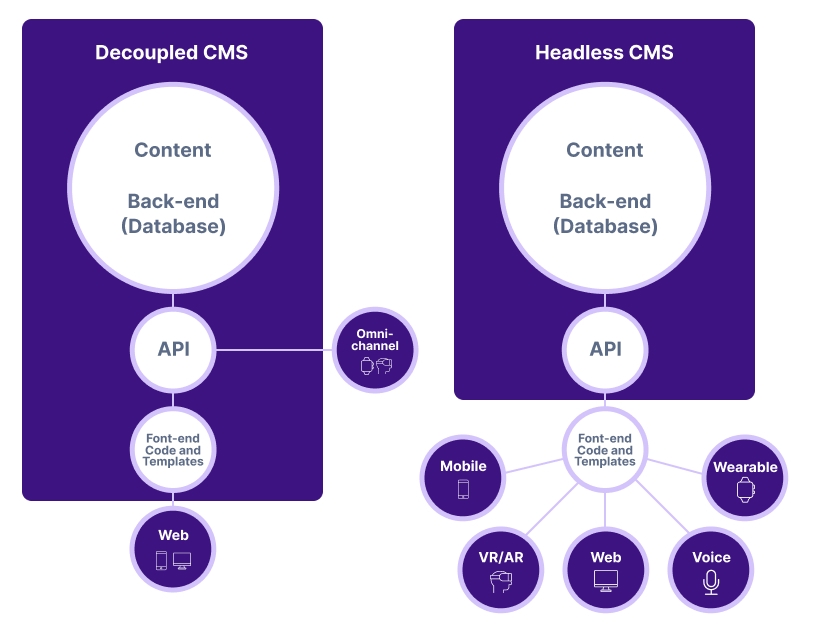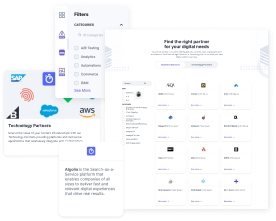What is a Headless CMS?
Headless CMS has been a rising trend – and popular buzzword – in digital content management for several years. The term CMS stands for content management system. This article explains the concept of the headless CMS, its benefits, and the type of companies that are going headless. Additionally, it shows how the digital content apocalypse has driven the change from traditional or legacy content management systems to more modern headless systems.
Headless CMS Explained in 2 Minutes
What is a Headless CMS?
Simply put, a headless CMS is a content management system that manages and organizes content without a connected front-end or display layer. The headless CMS is where all of your content and assets live. Then, you use a content API to distribute that content to anywhere and everywhere you need it — your website, your mobile app, your email marketing, your CRM, etc.
Here’s what that means in practice. Let’s call the part of the CMS that cares about the presentation the “head,” akin to how we care about the presentation of our physical heads.

Decoupled CMS and Headless CMS Architectures
The benefits of a headless CMS are immediate and compelling:
Ever since leading analyst firms identified the headless CMS trend (such as Forrester Research with its eponymous report on The Rise of the Headless CMS), enterprises and their IT departments have taken note. While many websites continue to be well served by the traditional CMS architecture, digital business leaders want to benefit from the improved time to market, the compelling economics and overall efficiencies that headless content management systems offer.
The headless CMS approach is quickly becoming a crucial component of the new generation of Digital Experience Platforms (DXPs). DXPs go significantly beyond web content management to create rich, engaging experiences for audiences across a multitude of channels. And what WYSIWYG was to the CMS of the 90s, the headless CMS has become for DXPs and future generations of content management.
A full appreciation of the business significance and the need for a headless content management system warrants a more thorough discussion. For a closely related topic, please read the article on What is a decoupled CMS?
Why Do You Need a Headless CMS?
The headless CMS is an essential piece of technology because we live in an omnichannel world. The content that enterprises create for their website also needs to appear on apps, integrations, newsletters, and more. And managing a duplicate copy of that content for multiple channels is a terrible, inefficient nightmare.
If your company makes an update to the way it describes a product, that update shouldn’t be copied and pasted in 20 different systems. You should be able to make the update in one centralized location and push the change out to all of the places where it matters.
That’s the power of a headless CMS.
It works as one central source of truth for all of your company’s content and assets. It gives you one place to manage, edit, update, and publish that content.
CMS Confronts Multifaceted Digital Content Consumption
Whereas many web properties have been built using a traditional CMS — Wordpress, Drupal, Joomla, etc. — the emergence of the headless CMS offers some significant benefits for firms that are growing into new channels, launching new products and integrations, or simply transact with customers across a range of touchpoints on multiple platforms and devices.
If we compare the headless CMS with a traditional CMS side-by-side, there are some significant advantages that headless offers that are not possible through most traditional CMS systems.
| Headless CMS Benefits | Explanation |
|---|---|
| Omnichannel Content Delivery | Headless CMS can power touchpoints across any channel or device. From websites to mobile apps, email marketing, voice-activated digital assistants, Apple Watch, AR/VR, and more. Content lives in a cloud-first content hub, and deployment is simple — nothing to install or manage. |
| Rapid Content Deployment (via API) | A headless CMS like Contentstack offers an API-first approach that makes it lightning-fast for developers to pipe in content. Using our Content-as-a-Service (CaaS) architecture, you can quickly scale or deploy new channels in an afternoon. |
| Modular Content and Assets | Because the content that lives in your headless CMS isn’t dependent on any specific front-end display, content becomes modular; it can be managed and deployed across any relevant touchpoint without being duplicated or reformatted. |
| Limitless Integrations that Power Next-Level Digital Experiences | The headless CMS allows you to connect content to a nearly infinite array of outside services and software. Your content is no longer siloed from systems like CRM, AI/ML, personalization tools, or localization platforms. |
Who Uses a Headless CMS?
Beyond the theoretical, many industries and verticals have embraced the headless CMS as a central platform that powers their entire digital experience across all devices and platforms. Headless CMS allows companies to connect with customers at scale, respond quickly to emerging market opportunities, and streamline content operations to enforce consistency while remaining agile.
Some of the industries using a headless CMS include:
Sports Teams
Powered by a headless CMS, sports teams can build an omnichannel fan engagement platform. By marrying content with personalized data, teams can help fans feel more connected than ever to the players they love most.
Read: Miami HEAT Delivers Realtime Personalized Digital Experiences with a Headless CMS
Airlines
Air carriers face some of the most complex content requirements of any industry. Their teams manage critical, real-time communications, global content translation and localization, plus an omnichannel presence that spans hundreds — if not thousands — of individual customer touchpoints. Across owned web properties, mobile apps, email, third-party search sites, and physical displays, a headless CMS enables clear, consistent, and simplified communications that are always accurate and up to date.
Financial Services
In the financial service sector, customers rely on real-time content to inform some of their most important life decisions. They also demand personalized content that helps them navigate complex processes and make smarter financial decisions. Firms need the flexibility to innovate while maintaining a rock-solid, reliable foundation for managing content, and how content is personalized and presented to each customer.
Read: Ellie Mae Increases Content Delivery and Decreases Development Costs with a Headless CMS
Online Retailers
In online retail, the customer experience is king. Customers are quick to criticize brands that fail to meet their needs — or even just introduce a tiny amount of friction into the buying process. Headless CMS allows online retailers to form 1:1 connections with customers, tying marketing and product content into customer purchase history and other data to deliver a truly personal shopping experience at scale.
Read: PhotoBox Streamlines Content Publishing with Contentstack’s Powerful APIs
Beyond these four core sectors, we also see many companies in other industries using a headless CMS to build a modern tech stack that marries flexibility with speed and innovation with security and reliability.
These industries include:
Headless vs. Legacy CMS
The headless CMS is a relatively new technology. So, what’s driven the need for a new way of building and managing website content? What’s gotten us to this point where headless technology is poised to dominate discussion about content management?
Following the early years of the Internet, the CMS emerged as an essential tool that allowed businesses to manage their website more easily. Some of the very first web content management tools of note were IBM’s FileNet and Vignette Story Server, which laid the foundation for what was to come next. These content management systems excelled at the creation of websites, firmly establishing the world’s first digital channel (i.e., the Web) as a vehicle to distribute digital content to growing online audiences.
Shortly after that, blogging became popular, and some of the most well-known CMSs emerged into the market — Drupal, WordPress, et al. WYSIWYG (“What You See Is What You Get”) editing became a popular content management system feature because it allowed for faster website creation and a quick QA process for published content.
But, this class of CMS has been confronting an existential challenge in the modern world. Connected devices have driven an explosion in the number of channels, screens, and formats for content. Any single piece of content can be re-structured and deployed in dozens or hundreds of contexts across a myriad of devices.
WYSIWYG editors are just not built to handle this level of complexity. Legacy CMS solutions handle 1:1 content deployment to a single web page. These systems can't handle the omnichannel world of mobile sites, apps, touchscreen displays, Alexa integrations, and smartwatch apps.
All of this presents a significant challenge for organizations that are using 20-year-old content management system technology. Where once it was advantageous to optimize for a single digital channel, all of a sudden, this highly streamlined CMS architecture is insufficient for a world in which content had to be available on many digital channels. From a technical perspective, the old model of intermingling content with the instructions for how to present it (i.e., HTML / CSS / JavaScript / etc.) falls short. Using this model, you can’t limit or control content because you don’t know where your digital content is going to surface next.
Read more about omnichannel content and the impact it has on digital experiences.
Learn the top 5 ways in which headless cms architecture advances innovation.
Related Articles
Here are other CMS articles we think you'll find useful.






9cb7.jpeg?format=pjpg&auto=webp)

